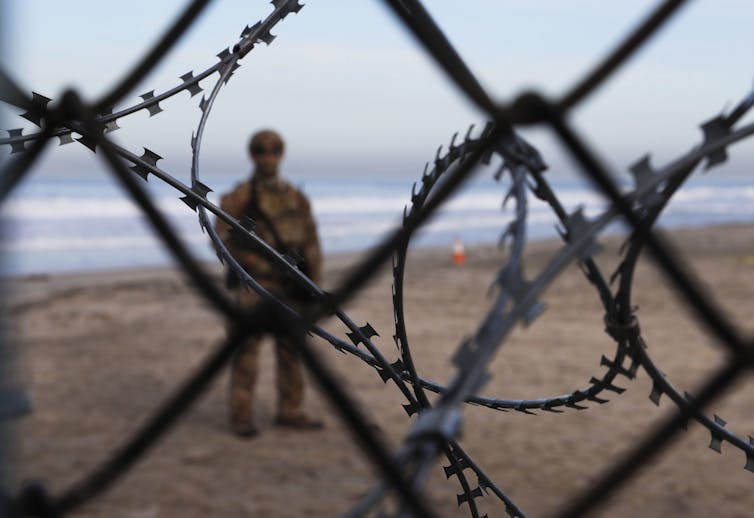Lead image by AP Photo/Andrew Harnik
By Laura Madokoro
This article is republished from The Conversation under a Creative Commons licence. All photos provided by The Conversation from various sources.
Concern is reportedly growing among some American legislators about migrants crossing into the United States from Canada.
One recent headline intoned: “U.S. Republicans are now warning: Migration from Canada is a problem” as some lawmakers have likened the apparent trend to “being assaulted.”
Since Republican governors started to send migrants arriving in their states to Democrat jurisdictions in the summer of 2022, the question of border control has been a major subject of public policy discussions in the United States.
In Canada, this topic gained traction when it was revealed that some American public officials have been facilitating the movement of people to the Canadian border, particularly to the unofficial crossing at Roxham Road in Québec.

THE CANADIAN PRESS/Ryan Remiorz
Public opinion polls, and heated rhetoric, are politicizing an issue that shouldn’t be political at all.
Since the rapid growth in the number of borders in the 19th century and the securitization and militarization of those borders in recent years, they’ve become a focal point in conversations about power and sovereignty. But they aren’t the real issue.
Borders simply offer an opportunity to score political points. In this case, it’s at the expense of migrants who have the right, under international law, to seek refuge.
Old anti-migrant playbook
By turning their attention to the Canada-U.S. border while also continuing to flag concerns about migration across the southern border with Mexico, American lawmakers are creating a perception that migration is a problem and polls show it’s reverberating domestically in Canada as well.
They’re also turning to a very old playbook in which migration across all borders is used to amplify the idea of migration as a threat.
In the 1880s, Canadian and American governments employed various measures to prevent both the continued migration of Chinese labourers to their shores as well as their permanent settlement.
Politicians had looked across the border (and across the Pacific to Australia) to see what kinds of measures were being envisioned elsewhere.
As historian Erika Lee has shown in her 2002 article in the Journal of American History, “Enforcing the Borders: Chinese Exclusion along the U.S. Borders with Canada and Mexico, 1882-1924,” this resulted in policymakers in the United States, in particular, using their ostensible concern about immigration issues as a way to deal with the so-called “Chinese problem.”
During that time period, the borders with both Canada and Mexico were seen as problematic by the United States, and migrants became the scapegoat in debates about American economic and social well-being. Crucially, this rhetoric was often racialized.
For example, Chinese migrants were depicted in editorials and editorial cartoons that featured gross distortions of their physical features and cultural practices.
By contrast, in the early 1900s, migrants from Syria, Greece, Hungary, Russia, France, Belgium and Spain were also known to have migrated to Canada first before making their way to the United States. This led to familiar complaints about Canada as a “back door” for entry to the United States, but in this case, the migrants themselves weren’t targeted.
But as Lee documented, they were often seen as the victims of “unscrupulous agents.”
Just as in the past, exploiting differences between migrants (in this case in terms of how they’re seeking refuge) creates greater inequalities and problems, and doesn’t attend to the core needs of migrants or potential host societies.
Larger systemic problems
The borders of the world are inextricably linked. What’s happening at the Canada-U.S. border is the result of growing numbers of dispossessed and displaced migrants globally and the failure of governments to grasp the fact that migrants themselves are not the problem.
Unfortunately, when people arrive in Canada uninvited — in other words, when they have not been selected in advance as part of a formal resettlement process — there is often visceral opposition. The presence of migrants at the border is seen as scary, in part because of the way this situation is presented by our neighbour to the south.
Given the history of the U.S.-Mexico border, and the highly militarized response to migrants arriving there, it’s not really a surprise that we’re now seeing similar anti-migrant rhetoric about the Canada-U.S. boundary too — and seeing lawmakers use words like “assault” to describe cross-border migration.

(AP Photo/Marco Ugarte)
But border arrivals, whether on land or at sea, have often been met with considerable outcry. This was the case with migrants who arrived by boat in Canada in 1987 and 1999.
The exception was perhaps in 2017, when Donald Trump’s administration inspired generosity in Canadian politicians, with Prime Minister Justin Trudeau famously tweeting #WelcomeToCanada in response to the announcement of Trump’s so-called Muslim ban.
Border politics
The current outrage about migrants from Canada entering the U.S., however, harkens back to an earlier period when borders were politicized with the goal of exclusion in mind.
The fact that some American politicians are once again asserting that migration across the Canada-U.S. border is a problem, and are using heated rhetoric to try to score political points on the issue, is having the biggest impact on the people at the heart of these migrations.
As was the case for Chinese migrants beginning in the 1880s, migrants are being exploited for partisan, nationalistic purposes. The potential for enduring harm is great.
All people have the right to seek refuge — indeed, the “right to seek asylum” and “enjoy in other countries asylum from persecution” is enshrined in the United Nations’ Universal Declaration of Human Rights, though the means to seek this right are less explicitly outlined.
Seeking to get political mileage out of a situation that stems from an ongoing global crisis and involves innocent people seeking better lives ignores bigger political, social, legal and economic conditions. Rather than demonize migrants, legislators everywhere should address the issues that lead them to migrate.
![]()
Tuesday, March 14, 2023 in The Conversation
Share: Twitter, Facebook



